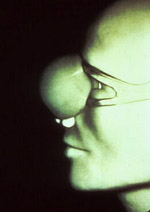

Eye
Injuries
|
Download a copy of this article in .pdf format |
| RACQUETBALL-RELATED
EYE INJURIES by Chuck Slonim, MD FACS |
|||||
| As
Americans become more health conscious, there has been
a recent trend for the couch potatoes of the world to
transform into the recreational athletes of
neighborhood. With this increased interest in sports
participation comes an increase in sports-related eye
injuries. There are over 100,000 such injuries
"reported" each year. About 44% of the
reported injuries were to children under the age of
14. Thus, young children should be protected, as any
eye injury could permanently end their future in
sports.
One of the most common causes of eye injuries among children and adults are sports activities. Sports that involve the use of a ball have the most reported eye injuries. Racquet sports (e.g., racquetball, tennis, squash, badminton, etc.) account for a significant number of sport-related eye injuries. Nonetheless, the most popular sports (i.e., basketball, baseball, and football) have the most numbers of such injuries because of the larger numbers of participants in these sports. The sad part about these eye injuries is that they often result in permanent damage, and over 90% of the injuries sustained could have been prevented.
Sports-related eye injuries can produce anywhere from minimal eye damage (scratches and/or abrasions) to injuries that can result in permanent loss of vision or even the loss of the eye itself (ocular hemorrhages, retinal detachments, open globe injuries, etc). Obviously, this depends on the nature of the injury. Preventing sports-related eye injuries is actually quite simple. There are two basic tasks that need to be undertaken prior to participating in any sport. The first task is a complete "screening" eye examination that should be performed by a qualified eye care practitioner on every athlete. There are three reasons for this. First, there could be an underlying or pre-existing eye problem that could increase the athlete's risk of injury by participating in a particular sport. Second, there could be an eye problem that could directly affect the athlete's ability to perform in a particular sport. And third, there could be an eye problem that could be worsened by an athlete's participation in a particular sport. If the eye exam reveals any evidence of eye problems, then certain limitations or restrictions could be placed on the athlete to prevent further harm. If you're a monocular athlete (a person with only one eye that sees well), you should always wear sports eye guards and consider not participating in a sport that put your only eye at risk of injury.
If a sports-related injury does occur, the athlete should be referred to a medical facility or to an eye care professional (ophthalmologist or optometrist) immediately if they experience:
If there is ever any doubt as to the nature of the eye injury, then the athlete should discontinue participating in the sport and should be referred immediately. The three most important words in sports-related eye injuries are protection, protection, and protection. There is no excuse for not wearing an eye protector when participating in racquetball or any other high-risk sport. |
|||||
|
Dr. Slonim is a Clinical Professor of Ophthalmology at the University of South Florida College of Medicine. He is the team ophthalmologist for many of the local professional and collegiate sports teams. Article is reprinted by permission of the author. Special thanks to Chuck Rousenberg for arranging this contribution to the website. Animated gif of racquetball provided courtesy of Loren Winters, High Speed Visual Imaging. |





 The second task is to
wear eye protectors, goggles, shields, or safety
glasses when participating in a sport that has a risk
of eye injuries. While worn, the risk of an eye injury
is dramatically reduced. Many batted and racquet-ed
balls can travel over 100 miles per hour (the
animated .gif at left illustrates a ball striking a
hard, flat surface at 60mph). The delicate
structures of the eye can be severely and irreversibly
damaged when impacted with a ball traveling at
velocities as high as that. Protecting the eye is
the key to preventing an eye injury. Here are some
tips when choosing your eye guards.
The second task is to
wear eye protectors, goggles, shields, or safety
glasses when participating in a sport that has a risk
of eye injuries. While worn, the risk of an eye injury
is dramatically reduced. Many batted and racquet-ed
balls can travel over 100 miles per hour (the
animated .gif at left illustrates a ball striking a
hard, flat surface at 60mph). The delicate
structures of the eye can be severely and irreversibly
damaged when impacted with a ball traveling at
velocities as high as that. Protecting the eye is
the key to preventing an eye injury. Here are some
tips when choosing your eye guards.